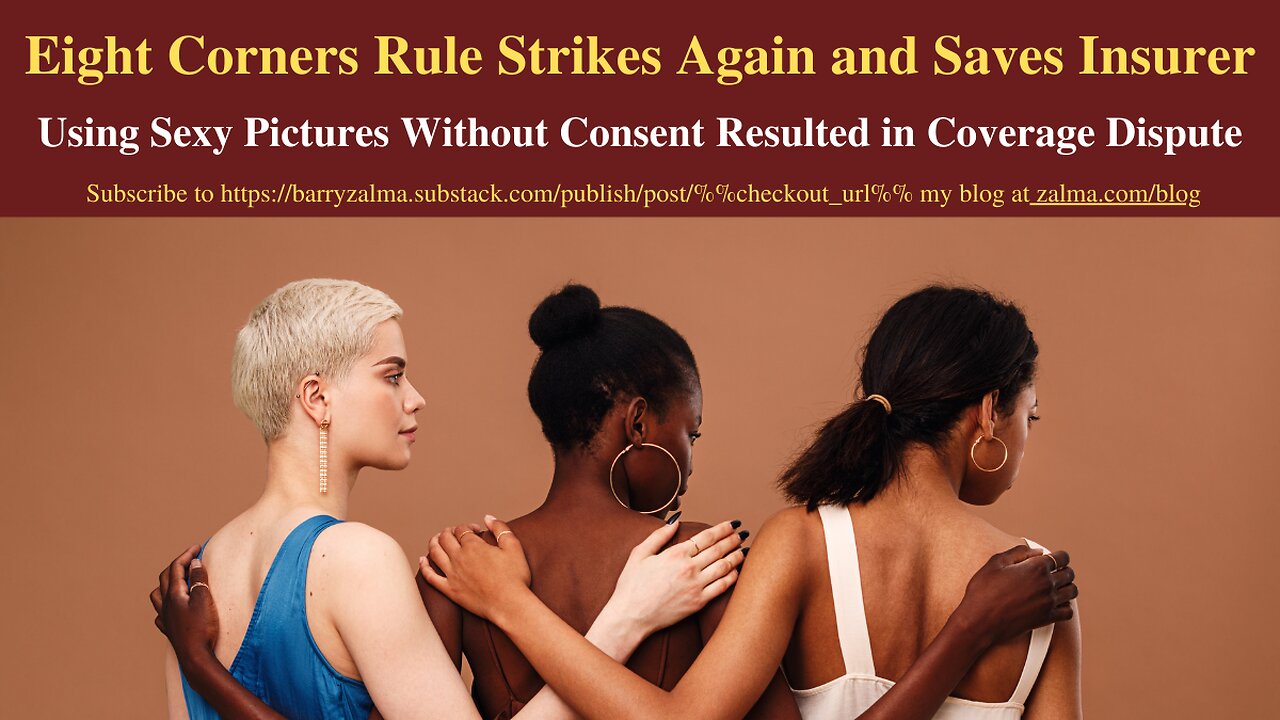Premium Only Content

Eight Corners Rule Strikes Again and Saves Insurer
Using Sexy Pictures Without Consent Resulted in Coverage Dispute
An insurance coverage dispute arising out of litigation in Texas state court. Two insurance policies are at issue, and the district court concluded that both provided the insureds coverage. The insurer appealed in The Princeton Excess and Surplus Lines Insurance Company v. A.H.D. Houston, Incorporated, doing business as Centerfolds; et al, No. 22-20473, United Stat
es Court of Appeals, Fifth Circuit (October 6, 2023)
FACTS
This comparatively pedestrian contract dispute stems from a much more salacious lawsuit filed in Texas in 2017. Sixteen professional models (the Models) sued three Texas strip clubs (the Clubs) following the Clubs' use of the Models' likeness for advertising campaigns without the Models' consent. The Clubs' advertising material was manipulated to give the impression that the Models endorsed the Clubs or worked as strippers in the Clubs. The Models claimed they were depicted in various sexually charged social media and Internet posts encouraging patrons to visit the Clubs. According to the Models, the Clubs participated in the selection, creation, and dissemination of these advertisements.
The state trial court granted summary judgment for the Models and awarded $1,405,000 in damages. The Clubs appealed. That appeal has not yet been finally adjudicated on the merits.
Meanwhile, Princeton Excess and Surplus Lines Insurance Company (PESLIC) filed a declaratory judgment action. PESLIC issued two commercial liability insurance policies to the Clubs that have identical coverage provisions but contain slightly different exclusions
The 01 Policy contains a "Field of Entertainment Exclusion."
The 02 Policy contains an "Exhibitions and Related Marketing Exclusion" that curtails coverage for Personal and Advertising Injury subsections d. through g.
As to the 01 Policy, the district court found that "the Models' pleadings in the underlying lawsuit sufficiently allege[d] that that the Clubs used [the] Models' images (i.e., their 'advertising ideas') and placed them in their own 'advertisements.'" Consequently, the district court held that PESLIC had a duty to defend and indemnify the Clubs under the 01 Policy.
As to the 02 Policy, the parties disputed whether that policy's Exhibitions and Related Marketing Exclusion rendered illusory the Personal and Advertising Injury coverage. The district court agreed with the Models and the Clubs that it did and "decline[d] to give effect to PESLIC's 'Exhibition and Related Marketing' exclusion." The trial court thus held that PESLIC had a duty to defend the Clubs. The district court also held that PESLIC had a duty to indemnify the Clubs under the 02 Policy.
DISCUSSION
In Texas, insurance policies are interpreted by the same principles as contract construction. The words of the policy are given their ordinary and generally accepted meaning unless the policy shows the words were meant in a technical or different sense. An insurance contract is ambiguous if it is subject to more than one reasonable interpretation.
Under Texas's well-established eight-corners rule, an insurer's duty to defend is determined by the claims alleged in the petition and coverage provided in the policy.
The 01 policy includes coverage for Personal and Advertising Injury. But it also includes a Field of Entertainment Exclusion, which narrows the scope of that coverage.
An insurance policy is not illusory merely because it does not provide coverage for a claim the policyholder thought it would cover. By its terms, the Field of Entertainment Exclusion eliminates coverage for most of the "advertising injuries" included in the 01 Policy's Coverage B-Personal and Advertising Injury Liability. But it expressly excepts injuries encompassed by subsection f., for the use of another's "advertising idea." The exclusion does not render coverage illusory and therefore is binding on the parties.
To sum up, the Field of Entertainment Exclusion is enforceable, as the 01 Policy nonetheless will provide coverage for other claims. Coverage under the policy is thus not illusory.
The Clubs took those products and used them without permission. Without more, taking and then advertising another's product is different from taking another's 'advertising idea. PESLIC, therefore, has no duty to defend the Clubs based on the 01 Policy's "advertising idea" coverage, and the district court erred in concluding otherwise.
The 02 Policy, which applies to most of the Models' claims turns on the policy's Exhibition and Related Marketing Exclusion, which eliminates coverage for Personal and Advertising Injury subsections d. through g. (pertaining to advertising injuries), to the extent "such activities arise out of or are part of 'exhibitions and related marketing.'"
The 02 Policy, is not illusory merely because it does not provide coverage for a claim the policyholders thought it would cover. Instead, the text of the 02 Policy is not ambiguous, and Texas law presumes that the party knows and accepts the contract terms. A lack of duty to indemnify can be inferred from a lack of duty to defend when the reasons that negate the duty to defend also negate any possibility the insurer will ever have a duty to indemnify.
PESLIC does not have a duty to defend the Clubs under the 01 Policy. Its duty to indemnify under the 01 Policy depends on final resolution of the state case. As for the 02 Policy, PESLIC does not have a duty to defend or indemnify under it because the 02 Policy does not provide coverage for the claims alleged by the Models. The district court erred by concluding otherwise.
ZALMA OPINION
The Eight Corners Rule limits the court coverage determination to the allegations of the complaint and the wording of the policies. Since the policies clearly excluded the claims of the models there was no coverage for a defense and as to one policy the results of the appeal of the Texas state curt action can determine the duty to indemnify while the other policy does not allow coverage for defense or indemnity.
(c) 2023 Barry Zalma & ClaimSchool, Inc.
Please tell your friends and colleagues about this blog and the videos and let them subscribe to the blog and the videos.
Subscribe to Excellence in Claims Handling at locals.com at https://zalmaoninsurance.locals.com/subscribe or at substack at https://barryzalma.substack.com/publish/post/107007808
Go to Newsbreak.com https://www.newsbreak.com/@c/1653419?s=01
Follow me on LinkedIn: www.linkedin.com/comm/mynetwork/discovery-see-all?usecase=PEOPLE_FOLLOWS&followMember=barry-zalma-esq-cfe-a6b5257
Daily articles are published at https://zalma.substack.com. Go to the podcast Zalma On Insurance at https://podcasters.spotify.com/pod/show/barry-zalma/support; Go to Barry Zalma videos at Rumble.com at https://rumble.com/c/c-262921; Go to Barry Zalma on YouTube- https://www.youtube.com/channel/UCysiZklEtxZsSF9DfC0Expg; Go to the Insurance Claims Library – http://zalma.com/blog/insurance-claims-library/
-
 7:40
7:40
Barry Zalma, Inc. on Insurance Law
1 year agoLoss of Inventory by Bankruptcy
184 -
 12:29
12:29
The Pascal Show
1 day ago $0.65 earnedLOCKED IN A DUNGEON?! Parents Arrested After 5 Children Found In 'Dungeon' At Home
5.68K3 -
 LIVE
LIVE
Lofi Girl
2 years agoSynthwave Radio 🌌 - beats to chill/game to
207 watching -
 3:07:24
3:07:24
FreshandFit
9 hours agoPrivileged Nigerian Thinks Women Created Everything: HEATED DEBATE
141K76 -
 5:57:27
5:57:27
SpartakusLIVE
9 hours agoNEW Update - BROKEN Attachment || Viewers REJOICE at the long-awaited Return of Their KING
74.9K -
 2:06:31
2:06:31
TimcastIRL
9 hours agoTrump To Deploy National Guard To Portland, Antifa Has Been WIPED OUT | Timcast IRL
189K152 -
 2:30:00
2:30:00
Laura Loomer
10 hours agoEP142: Loomer Prompts Calls For FBI To Investigate Palestinian Youth Movement
49.8K19 -
 1:26:34
1:26:34
Man in America
13 hours agoExposing the Cover-Up That Could Collapse Big Medicine: Parasites
56.3K23 -
 4:53:00
4:53:00
CHiLi XDD
8 hours agoTekken Fight Night
30K1 -
 9:25:57
9:25:57
ItsLancOfficial
14 hours agoFREAKY FRIDAY-GETTING FRIED-WELP! #TOTS
30.1K3